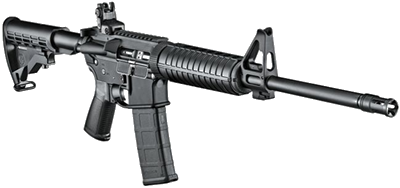Seems like the 300 BLK (300 Whisper/ 300 AAC/ 300 Blackout) is enjoying more and
more followers lately. The main reason must be that this caliber works just fine
in AR-type weapons. And, with the increased interest in suppressors, the 300 can
launch its projectiles at subsonic speeds, a perfect match. With heavy bullets
the subsonic ammo even works in ARs. Recently there were two places offering
brass for the 300 BLK, the cheapest asking for over $30 for fifty pieces of Hornady
brass.
With the Obama ammo crunch behind us, I do find .223 Rem brass again in our great
desert. Here, therefore, is an easy way to save brass money and make your own 300
BLK brass. For me anyway, the most difficult step in the .223 to 300 BLK conversion
was shortening/cutting off the .223 parent case. Now I’ve found a fast and easy method.
Begin with a fat nail or similar steel rod with a diameter of about 0.2 inches
(for instance ACE 20D 4”). Cut off the very tip, and bend that nail 90 degrees
about an inch from the end. Then, about .3 inches from that end, make a mark with
a hacksaw blade – see pictures.
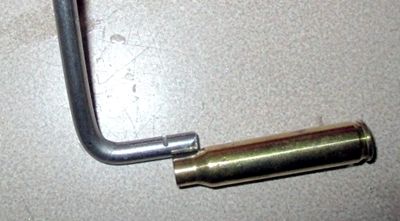
Bent nail with hacksaw cut mark
|
Here is the trick: in a vice, pinch the neck of a .223 case just enough so that the
vice will hold it there. Then insert the nail into the case mouth, but only so deep
that the hacksaw mark on the nail is still visible. Then tighten the vice. This does
not need to be a crushing clamp, just snug enough to firmly hold the case. The nail
prevents undue deformation of the case neck and for sure body. Now use a hacksaw to
cut the .223 case, just a little above where the shoulder begins. I use a Junior
Hacksaw (Buck Brothers) with as fine of a blade as I can find. (Note that similarly
this method can also be used to cut other brass, like making Herrett brass from
.30-30 Win cases). The cut-off neck is easily removed from the nail once it’s out
of the vice. Repeat the process for the next case.
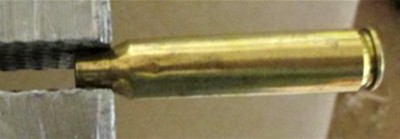
.223 case held in vise with light clamp force
|
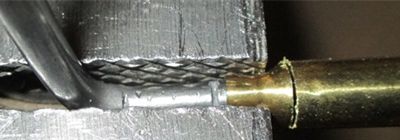
Nail inserted into case, and case clamped tight
enough to make the saw cut
|
With these .223 cases it is simple to chuck each into a power drill and thus quickly
deburr the inside and outside of the saw cut. With desert brass I also like to insert
a 38-caliber cleaning brush and run the drill for a second or three to remove any
possible dirt.
The next steps are typical. Lube the cut-off cases and run them through the
full-length 300 BLK (or Whisper) sizer die. Then trim to final length. For that
I use a (relatively new) Lyman 2-part trimmer. They are caliber-specific, therefore
not adjustable. Mine, for the 300 BLK, trims the cases to a length of 1.360”. The
cutter part attaches to a power drill. The deprimed case is held/ wedged in a shell
holder, where a threaded center that is just larger than the primer pocket pushes
against the base of the case, and in that way anti-rotates it during the trim process.
That center also acts as stop when the cutter trims the case mouth, and its extended
pilot sets the cutting length during the trimming operation. So, you hold the case
holder in one hand, and a drill with the cutter in the other. Trimming works best at
fairly slow speeds.
After trimming perform a final deburring, and the case is ready for priming, powder
and bullet.
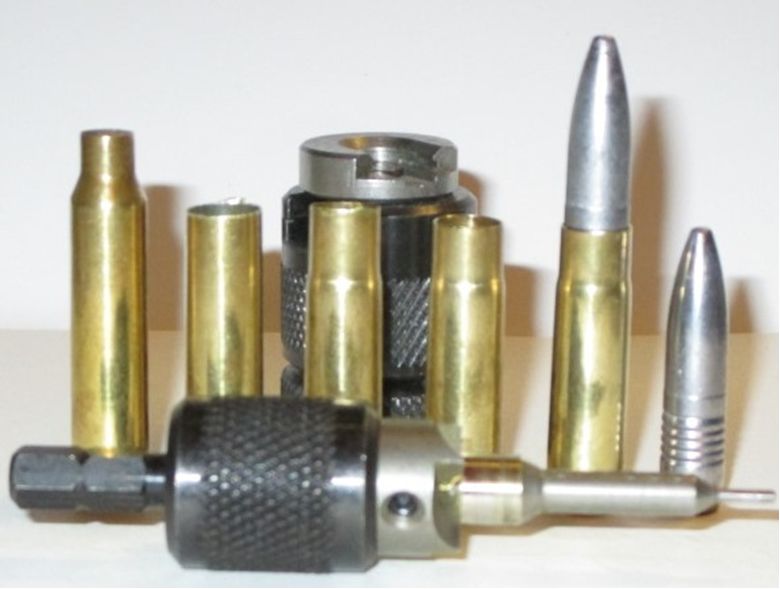
|
223 case; cut case; formed 300 BLK case; trimmed 300 BLK case; loaded 300 BLK round.
Note that the Lee 230gr lead bullet is about as long as the 300 BLK case.
In background the Lyman Trimmer case holder; in front the Lyman cutter for 300 BLK
|

![]()

